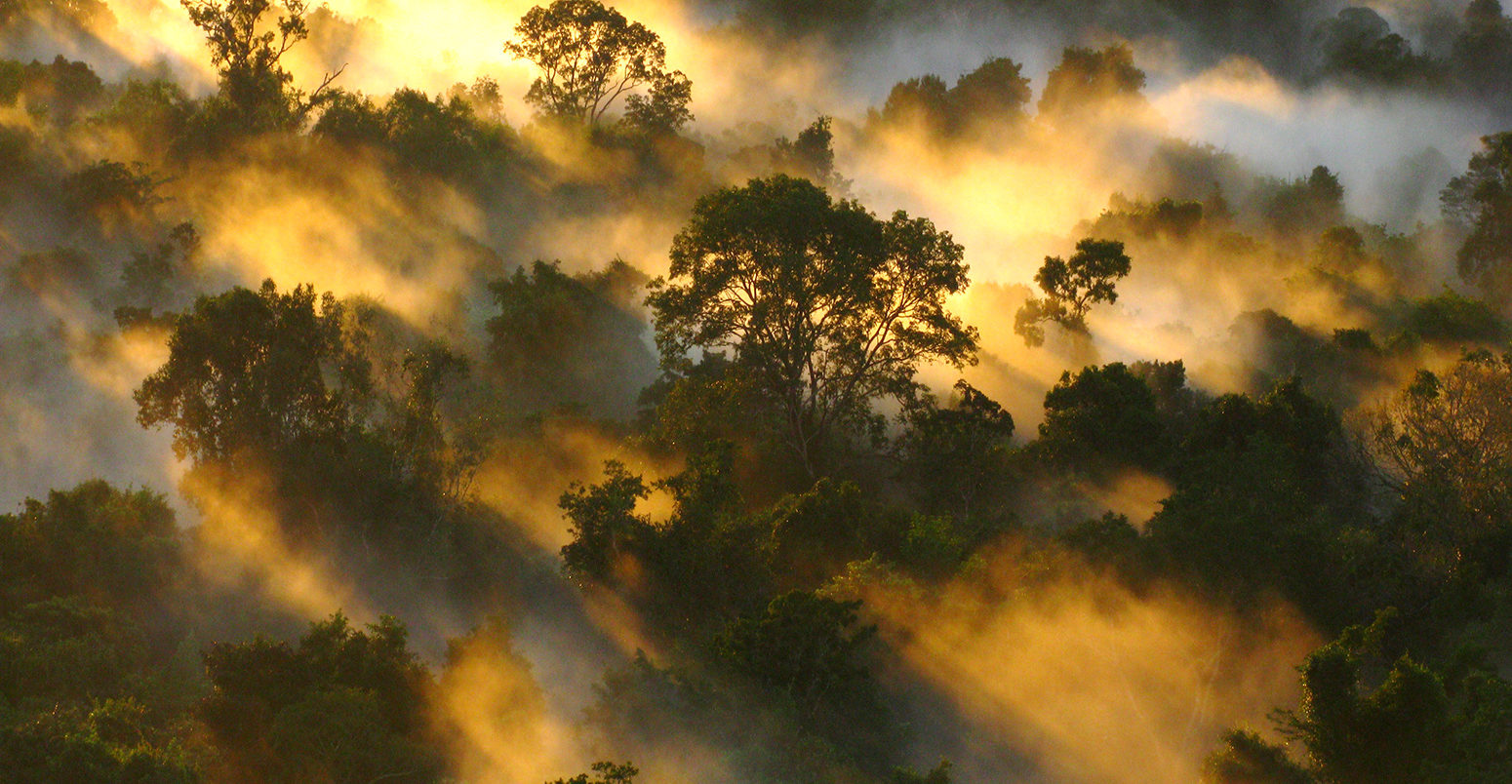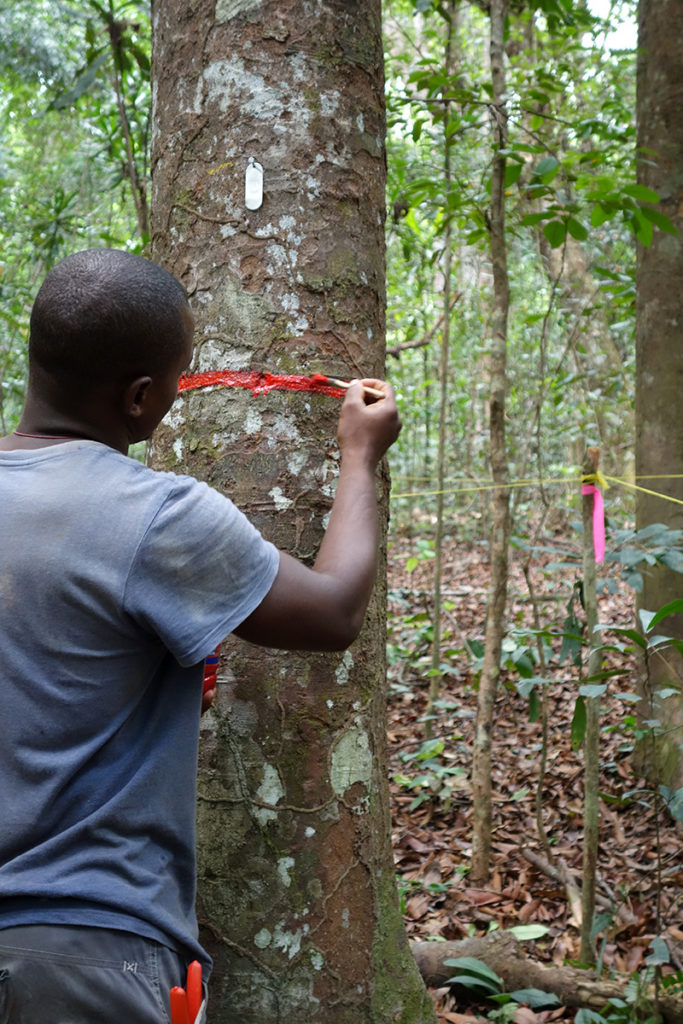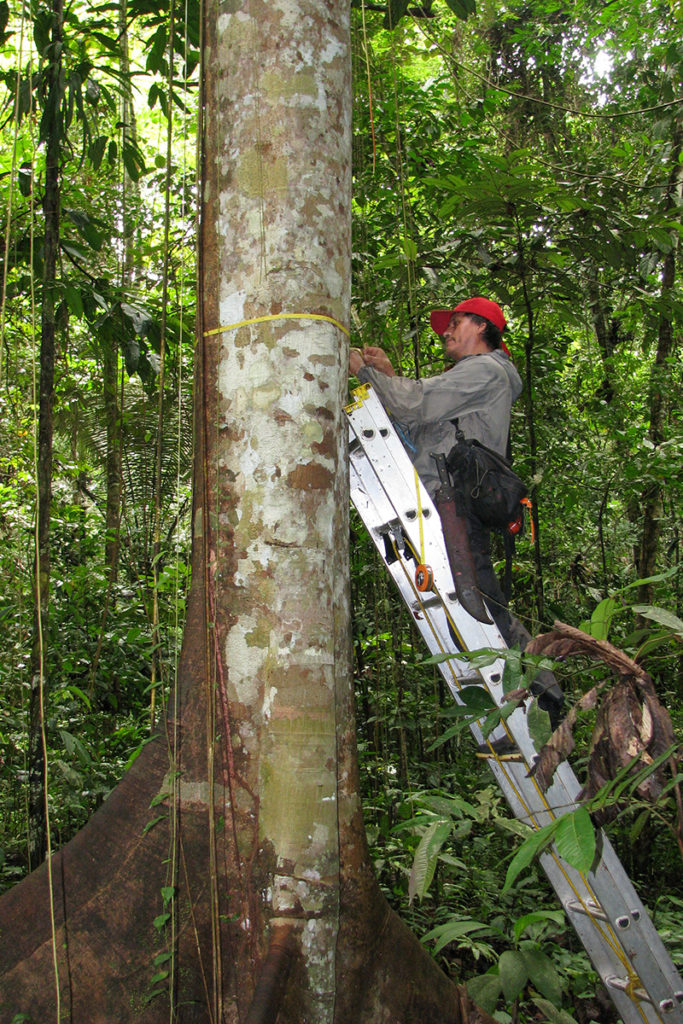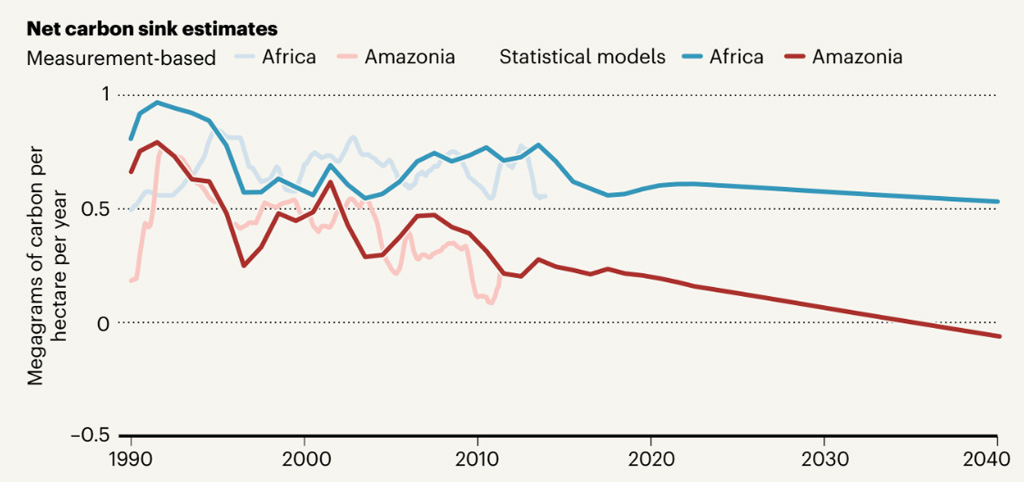
Guest post: World’s intact tropical forests reached ‘peak carbon uptake’ in 1990s

Prof Simon Lewis
03.04.20
Prof Simon Lewis
04.03.2020 | 4:00pmThe world’s land surface currently removes around 30% of all human-generated CO2 emissions, with tropical forests playing a major role in this “carbon sink”.
Of particular importance are intact tropical forests, which, according to a landmark paper published in 2011, absorbed 15% of all human-generated CO2 emissions between 1990 and 2007.
This research found that intact tropical forests that are undisturbed by either logging or fires were, on average, getting larger over time – thought to be driven by rising atmospheric CO2 levels boosting photosynthesis.
However, new research published this week in Nature, by myself and colleagues, paints a much more alarming picture of the role of tropical forests in slowing climate change.
Utilising two large forest datasets in Africa and South America spanning 300,000 trees, we show that the carbon sink in tropical forest is in rapid decline.
In fact, according to our analysis, the ability of intact tropical forests to remove CO2 from the atmosphere reached its peak in the 1990s and has since been in decline.
Tropical turmoil
Forests act as a net carbon sink when the amount of carbon gained through tree growth and the establishment of new trees is larger than the amount lost through tree mortality.
To evaluate how the sink is evolving over time, we made use of tree data stretching back 30 years. Every few years in the study period, research teams measured every tree in 565 patches of intact forest across the Amazon, the Congo Basin and West Africa.


The results show that, in the 1990s, the average undisturbed tropical forest removed 0.57 tonnes of carbon per hectare per year from the atmosphere. But this figure declined to an estimated 0.38 tonnes of carbon by the 2010s.
This is a one-third reduction in the carbon sink strength of intact tropical forests in just two decades.
If we extrapolate our results to consider all of the planet’s remaining intact tropical forests, we find that carbon uptake peaked at 1.26bn tonnes of carbon per year in the 1990s. This figure represents around 17% of all human-generated CO2 emissions at that time.
By the 2010s, the global uptake ability of tropical forests declined to 0.68bn tonnes of carbon per year. This is equivalent to just 6% of human-caused CO2 emissions in the 2010s.
It is worth noting that, over the study period, both the per unit area sink strength declined by 33% and the area of intact tropical forest declined by 19%, which also reduced the total rate of carbon uptake.
Tropical forests are still an important carbon sink. However, according to our results, the feared sink-to-source transition of one on Earth’s major carbon sinks has begun. This is decades earlier than any climate-driven vegetation model has predicted.
Dying trees
To understand why the carbon sink is decreasing, we analysed various factors that could be affecting tree growth and death.
Models typically predict that rising CO2 levels in the atmosphere will boost plant growth. This is because plants use CO2 during photosynthesis, the process needed to fix carbon to grow trunks, branches, roots and leaves. The impact of rising CO2 levels on plant growth is known as the “CO2 fertilisation effect”.
Our analysis shows, for the first time using inventory data, that across Africa and the Amazon, more CO2 in the atmosphere is boosting forest growth and this effect is not diminishing over time – just as models predicted.
However, despite the CO2 fertilisation effect, the sink is in decline.
This is because of the climate impacts of rising CO2 levels. Namely, higher temperatures and stronger drought conditions are slowing plant growth – and killing trees.
Overall, our analysis reveals that the balance of the ongoing positive impact of CO2 on photosynthesis and the increasingly negative impacts of temperature and drought is progressively moving in the direction of shutting down the sink over time.
Another factor playing a role is the life history of trees. Dynamic forests where trees die younger see their carbon sink saturating sooner than less dynamic forests, which tend to be dominated by very large trees.
Africa vs Amazonia
As part of our analysis, we looked at how the rate of carbon uptake differs between the world’s two largest areas of intact tropical forest: the Amazon region and in equatorial Africa.
Our results show that the Amazon sink started declining first, starting in the 1990s, followed by Africa, where we see a sink decline in the best-monitored plots beginning about 2010.
Amazon forests are declining earlier and faster than African forests because of three groups of factors.
First, trees in Amazonia tend to be more dynamic than those in Africa, with trees dying at a higher rate, meaning that past gains growth leave the system sooner resulting in an earlier saturating sink.
Second, the Amazon tends to experience higher temperatures because it is closer to sea level, faster temperature rises, and more frequent and severe droughts than African forests have experienced over recent decades.
Third, Amazon forest species appear less resistant to droughts than African forests. This may be because of the long-term climate history of African forests. The region has weathered large range contractions in glacial periods of Earth’s history, leaving more adaptable species that have survived past episodes of rapid environmental change.
Overall, African forests are more robust to recent contemporary environmental change than Amazon forests, our analysis suggests. While African forests cover much less area than Amazon forests, for the period 2000-10, the carbon sink was the same on both continents.
Forest forecast
For the final part of our study, we used the knowledge gleaned from our datasets to construct statistical models for forecasting changes to future tropical forest carbon uptake.
Using future CO2, temperature and rainfall estimates alongside our models, we predict that, on average, the per unit area carbon sink in African forest will be 14% smaller by 2030 compared to 2010-15 levels, while the average Amazon forest sink will reach zero by 2035.
Parts of the intact Amazon that are affected by drought could turn from a carbon sink to a carbon source, according to our analysis. This will be because carbon losses from tree mortality overtake carbon gains from growth.
Overall, we predict a sink-to-source transition of one of Earth’s major carbon sinks, with the Amazonia sink saturating first, followed later by the African sink.
The chart below shows how the ability of African forests (blue) and Amazonian forests (red) to uptake carbon is projected to change by 2040, calculated using our measurement-based statistical models.
(The chart also shows how our measurement-based assessment of carbon uptake in Amazonian and African forests from 1990 to present compares with projections from statistical models, which are shown in light blue for Africa and pink for Amazonia.)

Policy implications
Our findings highlight several key messages for policymakers. First, on-the-ground tropical forest monitoring programs need funding, as the changes we predict are subtle and cannot be deduced from satellite data alone.
Second, tropical forests matter. For now, they are still a carbon sink and will always be a large store of carbon. Forests’ resistance to climate change is relatively high if left undisturbed. Controlling logging and fires is essential.
Third, the need to reduce emissions to net zero just got more urgent. If society leaves it too late to tackle emissions, nature will make the job of controlling climate change much more difficult.
Finally, avoiding a transition to a carbon source will require stabilising the climate by reaching net-zero emissions. If tropical forests sequester less carbon than models predict, an earlier date by which to reach net zero will be required to meet the goals of the Paris Agreement.
Hubau, W. et al. (2020) Asynchronous carbon sink saturation in African and Amazonian tropical forests, Nature, https://www.nature.com/articles/s41586-020-2035-0
-
Guest post: World’s intact tropical forests reached ‘peak carbon uptake’ in 1990s

